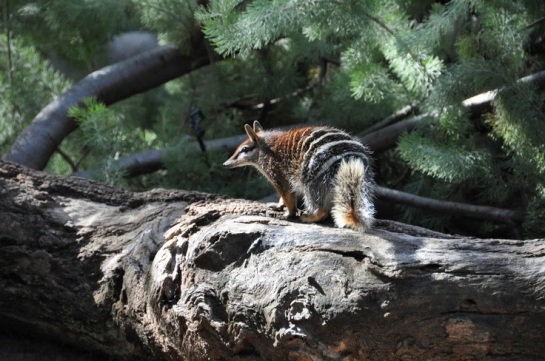
“If one way be better than another, that you may be sure is Nature’s way”
Aristotle – Nichomachean Ethics
One significant fact to cherish about the numbat is its relationship to the now extinct thylacine [1] or Tasmanian tiger. They were cousins. You may remember “Benjamin” the very last thylacine, who died in Hobart Zoo in 1936 in deeply sad circumstances. 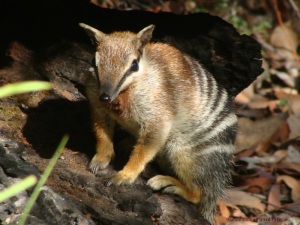 Ironically, the numbat is the only living member of its own family of marsupials – the Myrmecobiidae family . So it will be quite something if Australia manages to hang on to it. And… they are trying. A lot of dedicated people are doing all they can to keep the numbat alive, and, in general, it is held in quite high regard. In 1973, the then Governor of Western Australia, His Excellency Major General Sir Douglas Anthony Kendrew, declared and authorised this unique and rapidly declining species as the faunal emblem of the State of Western Australia.
Ironically, the numbat is the only living member of its own family of marsupials – the Myrmecobiidae family . So it will be quite something if Australia manages to hang on to it. And… they are trying. A lot of dedicated people are doing all they can to keep the numbat alive, and, in general, it is held in quite high regard. In 1973, the then Governor of Western Australia, His Excellency Major General Sir Douglas Anthony Kendrew, declared and authorised this unique and rapidly declining species as the faunal emblem of the State of Western Australia.
Perhaps, by way of apology!
Needless to say, these mammals are in danger of extinction in the wild because of man’s never-ending activities. Although these same activities began 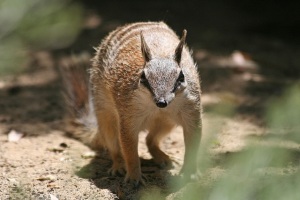 with the first European settlers, they have continued to this day. At one time, the numbat were widespread across Australia, but massive loss of habitat has left them confined to a few isolated pockets in Western Australia, where only two original populations still survive. Small numbers of the species have, however, been reintroduced there and in other areas as part of the significant conservation effort.
with the first European settlers, they have continued to this day. At one time, the numbat were widespread across Australia, but massive loss of habitat has left them confined to a few isolated pockets in Western Australia, where only two original populations still survive. Small numbers of the species have, however, been reintroduced there and in other areas as part of the significant conservation effort.
Agriculture, as usual, has done its bit, along with mining and humans building more and more settlements. Whereas the need for housing is not difficult to understand, after all we all need somewhere to live, if not for the expansion of farming and mining it wouldn’t have really been necessary to live within the range of the numbat and devour so much of its natural habitat. And… do we really need to cultivate every inch of land on the planet 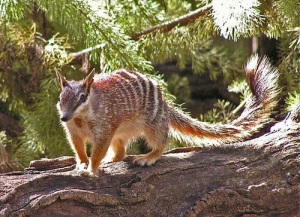 at the cost of its original inhabitants and the environment in general? The answer is a resounding NO.
at the cost of its original inhabitants and the environment in general? The answer is a resounding NO.
Numbats, also know as banded anteaters, favour environments where termites are plentiful, which means a habitat that is neither too wet nor too cold, and has areas where the sun can penetrate and stir the termites into action so the numbats can feed on them. So their free choices of living areas are limited to start with. The hollow fallen trees they shelter and nest in are fast-disappearing with these developments, and their only prey with them.
Bush fires have also taken the lives of many of these little creatures, as they have others animals and humans occasionally, which is more sad than reprehensible. But these fires make light work of the hollow logs the numbats use as their homes, again leaving the species without food and shelter. The loss of these hollow shelters has also made the numbat more vulnerable to predators.
The need to introduce predators such as red foxes and cats has never been adequately explained either. Both these species prey on the poor little numbats and have had a devastating effect on the population.
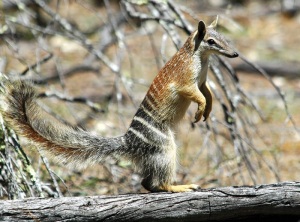 Personally, I think these little animals are adorable, and with a name like numbat, who could possibly fail to be drawn to them and their plight.
Personally, I think these little animals are adorable, and with a name like numbat, who could possibly fail to be drawn to them and their plight.
Numbats are small animals with pointed heads, long faces and tiny ears. They have squirrel-like bushy tails and short legs. Small enough to be weighed in grams, they come in at between four and seven hundred of them. They can grow up to twelve inches in length, with a tail of about seven inches. The males are larger and heavier than the females. Coats vary from greyish-brown to darker shades of red on the shoulders and head. Numbats have a pale underside and a black stripe across the eyes. They also have very distinctive black and white banding on the back and rump showing a remarkable colour resemblance to their cousins, the lost Tasmanian tigers. Numbats have strong claws with five toes on the forefeet and four on the hind feet, and the ability to stand on their hind legs when feeling curious or threatened.
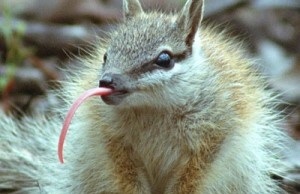 The species has some fascinating adaptations, too:
The species has some fascinating adaptations, too:
The long narrow snout is designed for finding the corridors termites travel along and the small holes in the ground they occupy. Numbats sense the presence of the termites they love so much by using olfactory perception.
They have a long thin tongue, which they like to keep ‘well-oiled’ with saliva to maintain its stickiness. This tongue is perfectly modified to retrieve the day’s newly discovered termites and enjoy a hearty meal. There are multiple ridges along the numbat’s soft palate to scrape the termites off the tongue .
And, they have a mouth full of non-functional teeth set in an under-developed jaw. There is little need for numbats to chew their food, so teeth are not an issue.
Numbats are strictly diurnal and one of the only two Australian marsupials to be so. The other is the musky rat-kangaroo. Their daylight activity is closely associated with that of its termite prey. Termites are out and about early in the day in the summer, before the sun gets too hot and they feel the need to take refuge from the heat in deeper soil. As the day cools, the termites reappear. In winter, termites tend to stay out of reach until mid to late morning when the soil starts to warm up, and will remain active until dusk arrives. These movements dictate the feeding and resting patterns of the numbats.
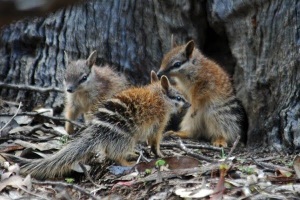 Numbats are mostly solitary animals, coming together only during mating. With the exception of a mother and her young, the species is rarely seen together. The mating season runs from December to January. After a gestation period of fourteen days, the mother will give birth to up to four babies. Numbats do not have a pouch and the babies will be kept warm by the long underside hairs of the mother. The babies will latch on to the mother’s teats, which in turn swell in their mouths preventing them from dropping off. The babies, born bind and hairless, will learn to cling whilst growing. Sweetly, the babies’ noses are flat allowing them to get close to their mothers and feed. When they are big enough to eat termites, their long noses will develop to accommodate that action, too. The rest of their first year will see them deposited in a nest, weaned, eating termites and gaining independence before going their own way at twelve months.
Numbats are mostly solitary animals, coming together only during mating. With the exception of a mother and her young, the species is rarely seen together. The mating season runs from December to January. After a gestation period of fourteen days, the mother will give birth to up to four babies. Numbats do not have a pouch and the babies will be kept warm by the long underside hairs of the mother. The babies will latch on to the mother’s teats, which in turn swell in their mouths preventing them from dropping off. The babies, born bind and hairless, will learn to cling whilst growing. Sweetly, the babies’ noses are flat allowing them to get close to their mothers and feed. When they are big enough to eat termites, their long noses will develop to accommodate that action, too. The rest of their first year will see them deposited in a nest, weaned, eating termites and gaining independence before going their own way at twelve months.
[1] Various sightings of thylacine have been reported over the past decades and it seems there is a vague possibility the species may be extant.
Natural Habitat
Eucalypt forests and woodlands
Where
Western Australia | Scotia Sanctuary in New South Wales | Yookamura Sanctuary in South Australia
What they eat
Termites – Adults eat roughly twenty thousand termites a day (they do not eat ants despite their other name of banded anteater)
Threats
Feral cats and foxes; these are predators which have been introduced to the numbat’s natural habitat. Natural predators such as pythons, eagles and goshawks. Loss of habitat due to agricultural development, bushfires, mining and residential development.
Status: Endangered
The Numbat (Myrmecobius fasciatus) is listed on the IUCN Red List of Threatened Species as Endangered. It is also listed as a threatened species under Australian law. Numbers are low in the wild, but the species is being reintroduced, successfully boosting the numbat population and helping to combat the threat of extinction. Perth Zoo, the world’s only captive breeding centre for numbats, breeds and returns the animals back into the wild on an annual basis as part of its Native Species Breeding Program. Care is now also being taken to release the numbats into fox-free areas.
Related Articles
Where to See Numbats
Perth Zoo’s numbats evade squirts and birds to make it alive in the wild